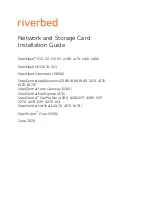
Intel
®
81341 and 81342 I/O Processors
December 2007
Developer’s Manual
Order Number: 315037-002US
927
I
2
C Bus Interface Units—Intel
®
81341 and 81342
16.3.6
General Call Address
The I
2
C unit supports both sending and receiving general call address transfers on the
I
2
C bus. When sending a general call message from the I
2
C unit, software must set the
General Call Disable bit in the ICR to keep the I
2
C unit from responding as a slave.
Failure to set this bit causes the I
2
C Bus to enter an indeterminate state.
A general call address is defined as a transaction with a slave address of 00H. When a
device requires the data from a general call address, it acknowledges the transaction
and stays in slave-receiver mode. Otherwise, the device can ignore the general call
address. The second and following bytes of a general call transaction are acknowledged
by every device using it on the bus. Any device not using these bytes must not Ack.
The meaning of a general call address is defined in the second byte sent by the master-
shows a general call address transaction. The least significant
bit (B) of the second byte defines the transaction.
Table 586, “General Call Address
Second Byte Definitions” on page 927
shows the valid values and definitions when
B=0.
When the 81341 and 81342 is acting as a slave, and the I
2
C unit receives a general call
address and the ICR General Call Disable bit is clear the I
2
C unit:
• Sets the ISR general call address detected bit
• Sets the ISR slave address detected bit
• Interrupts (when enabled) the 81341 and 81342
When the I
2
C unit receives a general call address and the ICR General Call Disable bit is
set, the I
2
C unit ignores the general call address.
When directed to reset, the I
2
C Bus Interface Unit returns to its default reset condition
with the exception of the ISAR. The 81341 and 81342 is responsible for ensuring this
occurs, not the I
2
C Bus Interface Unit hardware.
When B=1, the sequence is used as a hardware general call by hardware masters only
they cannot transmit a slave address, only their own address. The I
2
C Bus Interface
Unit does not support this mode of operation.
I
2
C 10-bit addressing and CBUS compatibility are not supported.
Figure 154. General Call Address
Table 586. General Call Address Second Byte Definitions
Least Significant Bit
of Second Byte (B)
Second Byte Value
Definition
0
06H
2-byte transaction where the second byte tells the slave to reset and then store
this value in the programmable part of their slave address.
0
04H
2-byte transaction where the second byte tells the slave to store this value in the
programmable part of their slave address. No reset.
0
00H
Not allowed as a second byte
Master to Slave
Slave to Master
START 00000000 ACK
Data
Byte
ACK
Data
Byte
STOP
N Bytes + ACK
Least Significant Bit of Master
Address Defines Transaction
ACK
Second Byte
Second
Byte
0 ACK
First Byte
B6295-01
















































